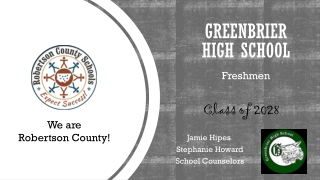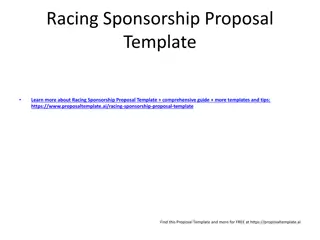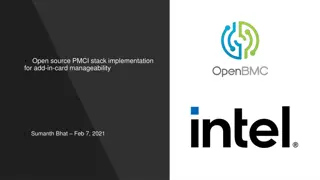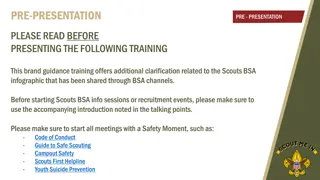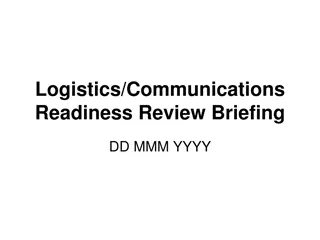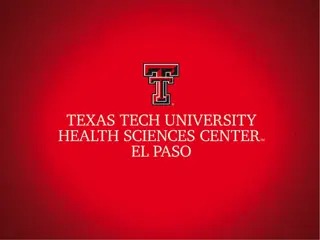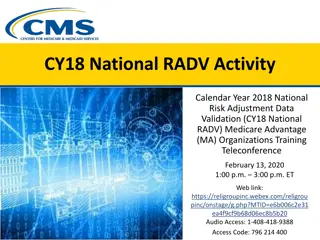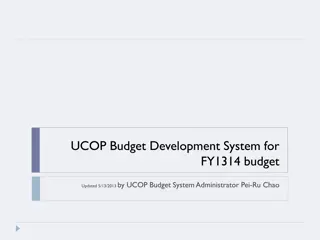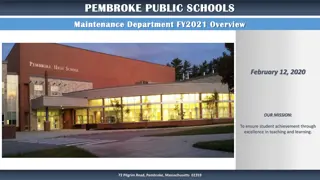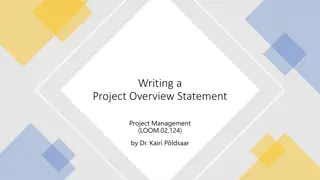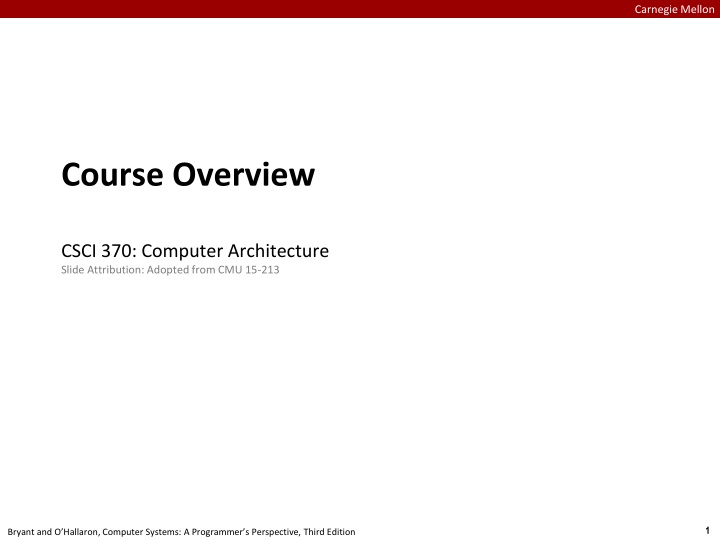
Computer Architecture and Arithmetic Realities at Carnegie Mellon
Explore the course overview of CSCI 370 at Carnegie Mellon, focusing on computer architecture and arithmetic realities. Discover how this course fits into the computer science curriculum, emphasizing the importance of understanding abstractions and underlying implementations for effective programming. Gain insights into the differences between integers and floats, the properties of computer arithmetic, and the essential considerations for compiler writers and application programmers. Prepare yourself for a deeper understanding of computer systems and programming efficiency.
Download Presentation

Please find below an Image/Link to download the presentation.
The content on the website is provided AS IS for your information and personal use only. It may not be sold, licensed, or shared on other websites without obtaining consent from the author. If you encounter any issues during the download, it is possible that the publisher has removed the file from their server.
You are allowed to download the files provided on this website for personal or commercial use, subject to the condition that they are used lawfully. All files are the property of their respective owners.
The content on the website is provided AS IS for your information and personal use only. It may not be sold, licensed, or shared on other websites without obtaining consent from the author.
E N D
Presentation Transcript
Carnegie Mellon Course Overview CSCI 370: Computer Architecture Slide Attribution: Adopted from CMU 15-213 1 Bryant and O Hallaron, Computer Systems: A Programmer s Perspective, Third Edition
Carnegie Mellon Overview Course theme Five realities How the course fits into the CS curriculum Academic integrity 2 Bryant and O Hallaron, Computer Systems: A Programmer s Perspective, Third Edition
Carnegie Mellon Course Theme: Abstraction Is Good But Don t Forget Reality Most CS courses emphasize abstraction Abstract data types, Asymptotic analysis These abstractions have limits Especially in the presence of bugs Need to understand details of underlying implementations Useful outcomes from taking CSCI 370 Understand computer architecture Translation between high-level code and how it runs! Become more effective programmers Able to find and eliminate bugs efficiently Able to understand and tune for program performance Prepare for later systems classes Compilers, Operating Systems, Parallel Programming, etc. 3 Bryant and O Hallaron, Computer Systems: A Programmer s Perspective, Third Edition
Carnegie Mellon Great Reality #1: Ints are not Integers, Floats are not Reals Example 1: Is x2 0? Float s: Yes! Int s: 40000 * 40000 1600000000 50000 * 50000 ?? Example 2: Is (x + y) + z = x + (y + z)? Unsigned & Signed Int s: Yes! Float s: (1e20 + -1e20) + 3.14 --> 3.14 1e20 + (-1e20 + 3.14) --> ?? Source: xkcd.com/571 4 Bryant and O Hallaron, Computer Systems: A Programmer s Perspective, Third Edition
Carnegie Mellon Computer Arithmetic Does not generate random values Arithmetic operations have important mathematical properties Cannot assume all usual mathematical properties Due to finiteness of representations Integer operations satisfy ring properties Commutativity, associativity, distributivity Floating point operations satisfy ordering properties Monotonicity, values of signs Observation Need to understand which abstractions apply in which contexts Important issues for compiler writers and serious application programmers 5 Bryant and O Hallaron, Computer Systems: A Programmer s Perspective, Third Edition
Carnegie Mellon Great Reality #2: You ve Got to Know Assembly Chances are, you ll never write programs in assembly Compilers are much better & more patient than you are But: Understanding assembly is key to machine-level execution model Behavior of programs in presence of bugs High-level language models break down Tuning program performance Understand optimizations done / not done by the compiler Understanding sources of program inefficiency Implementing system software Compiler has machine code as target Operating systems must manage process state Creating / fighting malware x86 assembly is the language of choice! 6 Bryant and O Hallaron, Computer Systems: A Programmer s Perspective, Third Edition
Carnegie Mellon Great Reality #3: Memory Matters Random Access Memory Is an Unphysical Abstraction Memory is not unbounded It must be allocated and managed Many applications are memory dominated Memory referencing bugs especially pernicious Effects are distant in both time and space Memory performance is not uniform Cache and virtual memory effects can greatly affect program performance Adapting program to characteristics of memory system can lead to major speed improvements 7 Bryant and O Hallaron, Computer Systems: A Programmer s Perspective, Third Edition
Carnegie Mellon Memory Referencing Bug Example typedef struct { int a[2]; double d; } struct_t; double fun(int i) { volatile struct_t s; s.d = 3.14; s.a[i] = 1073741824; /* Possibly out of bounds */ return s.d; } fun(0) fun(1) fun(2) fun(3) fun(4) fun(6) 3.14 3.14 3.1399998664856 2.00000061035156 3.14 Segmentation fault Result is system specific 8 Bryant and O Hallaron, Computer Systems: A Programmer s Perspective, Third Edition
Carnegie Mellon Memory Referencing Bug Example fun(0) fun(1) fun(2) fun(3) fun(4) fun(6) typedef struct { int a[2]; double d; } struct_t; 3.14 3.14 3.1399998664856 2.00000061035156 3.14 Segmentation fault Explanation: Critical State 6 ? 5 ? 4 Location accessed by fun(i) d7 ... d4 3 d3 ... d0 2 struct_t a[1] 1 a[0] 0 9 Bryant and O Hallaron, Computer Systems: A Programmer s Perspective, Third Edition
Carnegie Mellon Memory Referencing Errors C and C++ do not provide any memory protection Out of bounds array references Invalid pointer values Abuses of malloc/free Can lead to nasty bugs Whether or not bug has any effect depends on system and compiler Action at a distance Corrupted object logically unrelated to one being accessed Effect of bug may be first observed long after it is generated How can I deal with this? Program in Java, Ruby, Python, ML, Understand what possible interactions may occur Use or develop tools to detect referencing errors (e.g. Valgrind) 10 Bryant and O Hallaron, Computer Systems: A Programmer s Perspective, Third Edition
Carnegie Mellon Great Reality #4: There s more to performance than asymptotic complexity Constant factors matter too! And even exact op count does not predict performance Easily see 10:1 performance range depending on how code written Must optimize at multiple levels: algorithm, data representations, procedures, and loops Must understand system to optimize performance How programs compiled and executed How to measure program performance and identify bottlenecks How to improve performance without destroying code modularity and generality 11 Bryant and O Hallaron, Computer Systems: A Programmer s Perspective, Third Edition
Carnegie Mellon Memory System Performance Example void copyij(int src[2048][2048], int dst[2048][2048]) { int i,j; for (i = 0; i < 2048; i++) for (j = 0; j < 2048; j++) dst[i][j] = src[i][j]; } void copyji(int src[2048][2048], int dst[2048][2048]) { int i,j; for (j = 0; j < 2048; j++) for (i = 0; i < 2048; i++) dst[i][j] = src[i][j]; } 81.8ms 4.3ms2.0 GHz Intel Core i7 Haswell Hierarchical memory organization Performance depends on access patterns Including how step through multi-dimensional array 12 Bryant and O Hallaron, Computer Systems: A Programmer s Perspective, Third Edition
Why The Performance Differs copyij 16000 14000 Read throughput (MB/s) 12000 10000 8000 6000 4000 2000 copyji 0 32k s1 128k s3 512k s5 2m s7 8m Stride (x8 bytes) s9 Size (bytes) 32m s11 128m 13 Bryant and O Hallaron, Computer Systems: A Programmer s Perspective, Third Edition
Carnegie Mellon Great Reality #5: Computers do more than execute programs They need to get data in and out I/O system critical to program reliability and performance They communicate with each other over networks Many system-level issues arise in presence of network Concurrent operations by autonomous processes Coping with unreliable media Cross platform compatibility Complex performance issues 14 Bryant and O Hallaron, Computer Systems: A Programmer s Perspective, Third Edition
Carnegie Mellon Course Perspective Most Systems Courses are Builder-Centric Computer Architecture Design pipelined processor in Verilog (we are NOT this hardcore) Operating Systems Implement sample portions of operating system Compilers Write compiler for simple language Networking Implement and simulate network protocols 15 Bryant and O Hallaron, Computer Systems: A Programmer s Perspective, Third Edition
Carnegie Mellon Role within CS Curriculum CSCI 476 Parallel Programming CSCI 380 Operating Systems CSCI 395 Networks CSCI 435 Compilers Processes Mem. Mgmt Virtual Mem. Machine Code Machine Code Mem. Hierarchy System I/O 370 16 Bryant and O Hallaron, Computer Systems: A Programmer s Perspective, Third Edition
Carnegie Mellon Cheating: Description Please pay close attention What is cheating? Sharing code: by copying, retyping, looking at, or supplying a file Describing: verbal description of code from one person to another. Coaching: helping your friend to write a lab, line by line Searching the Web for solutions Copying code from a previous course or online solution You are only allowed to use code we supply, or from the CS:APP website What is NOT cheating? Explaining how to use systems or tools Helping others with high-level design issues See the course syllabus for details. Ignorance is not an excuse 17 Bryant and O Hallaron, Computer Systems: A Programmer s Perspective, Third Edition
Carnegie Mellon Cheating: Consequences Penalty for cheating: Automatic zero on assignment Permanent mark on your record Your instructors personal contempt Detection of cheating: We have sophisticated tools for detecting code plagiarism (MOSS) I cross-check your submissions with what I ve scraped from Github (>3K) Don t do it! Start early Ask me for help when you get stuck 18 Bryant and O Hallaron, Computer Systems: A Programmer s Perspective, Third Edition
Carnegie Mellon Textbooks Randal E. Bryant and David R. O Hallaron, Computer Systems: A Programmer s Perspective, Third Edition (CS:APP3e), Pearson, 2016 http://csapp.cs.cmu.edu This book really matters for the course! How to solve labs Practice problems typical of exam problems Brian Kernighan and Dennis Ritchie, The C Programming Language, Second Edition, Prentice Hall, 1988 Still the best book about C, from the originators 19 Bryant and O Hallaron, Computer Systems: A Programmer s Perspective, Third Edition
Carnegie Mellon Course Components Lectures Higher level concepts Applied concepts, important tools and skills for labs, clarification of lectures, exam coverage Labs (4) The heart of the course 2-3 weeks each Provide in-depth understanding of an aspect of systems Programming and measurement Exams (midterm + final) Test your understanding of concepts & mathematical principles 20 Bryant and O Hallaron, Computer Systems: A Programmer s Perspective, Third Edition
Carnegie Mellon Getting Help Class Web page: http://cs.millersville.edu.edu/~wkillian/2019/fall/csci370 Complete schedule of lectures, exams, and assignments Copies of lectures, assignments, exams, solutions Clarifications to assignments Email Contact me if you have questions! I will send out announcements Office Hours 5 (minimum) per week 21 Bryant and O Hallaron, Computer Systems: A Programmer s Perspective, Third Edition
Carnegie Mellon Policies: Labs And Exams Work groups You must work alone on all lab assignments Handins Labs due at 11:59pm on Tues or Thurs Electronic handins using Autolab (no exceptions!) Exams Exams will be during class time Appealing grades In email to Prof Killian within 7 days of completion of grading Follow formal procedure described in syllabus 22 Bryant and O Hallaron, Computer Systems: A Programmer s Perspective, Third Edition
Carnegie Mellon Facilities Labs will use the Linux Lab Machines linux> ssh {computer_name}.cs.millersville.edu 27 Intel machines running Arch Linux Each machine: i7 (Skylake): 4 cores, 16 GB DRAM Login using your myVille ID and password Getting help with the command line: Please direct questions to me Grading Performed on autolab (very similar to the Linux Lab) 23 Bryant and O Hallaron, Computer Systems: A Programmer s Perspective, Third Edition
Carnegie Mellon Timeliness Grace days 3 grace days for the semester Limit of 2 grace days per lab used automatically Covers scheduling crunch, out-of-town trips, illnesses, minor setbacks Save them until late in the term! Lateness penalties Once grace day(s) used up, get penalized 25% per day No handins later than 3 days after due date Catastrophic events Major illness, death in family, Formulate a plan (with your academic advisor) to get back on track Advice Once you start running late, it s really hard to catch up 24 Bryant and O Hallaron, Computer Systems: A Programmer s Perspective, Third Edition
Carnegie Mellon Other Rules of the Lecture Hall Laptops: permitted Electronic communications: forbidden No email, instant messaging, cell phone calls, etc forbidden Presence in lectures: voluntary, strongly recommended Presence during scheduled lab time: mandatory Voice recordings: acceptable 25 Bryant and O Hallaron, Computer Systems: A Programmer s Perspective, Third Edition
Carnegie Mellon Policies: Grading Exams (60%): midterm (30%), final (30%) Labs (40%): weighted according to points Final grades based on a straight 10-point scale 26 Bryant and O Hallaron, Computer Systems: A Programmer s Perspective, Third Edition
Carnegie Mellon Programs and Data Topics Bits operations, arithmetic, assembly language programs Representation of C control and data structures Includes aspects of architecture and compilers Assignments L1 (datalab): Manipulating bits L2 (bomblab): Defusing a binary bomb 27 Bryant and O Hallaron, Computer Systems: A Programmer s Perspective, Third Edition
Carnegie Mellon Architecture & Pipeline Topics 5-stage pipeline implementation Hardware control language Optimization of assembly Assignments L3 (archlab): Enhancing an existing ISA 28 Bryant and O Hallaron, Computer Systems: A Programmer s Perspective, Third Edition
Carnegie Mellon The Memory Hierarchy Topics Memory technology, memory hierarchy, caches, disks, locality, IO Includes aspects of architecture and OS Assignments L4 (cachelab): Building a cache simulator and optimizing for locality. Learn how to exploit locality in your programs. 29 Bryant and O Hallaron, Computer Systems: A Programmer s Perspective, Third Edition
Carnegie Mellon Exceptional Control Flow Topics Hardware exceptions, Includes aspects of compilers, OS, and architecture Assignments None 30 Bryant and O Hallaron, Computer Systems: A Programmer s Perspective, Third Edition
Carnegie Mellon Virtual Memory Topics Virtual memory, address translation Includes aspects of architecture and OS Assignments None 31 Bryant and O Hallaron, Computer Systems: A Programmer s Perspective, Third Edition
Carnegie Mellon Grab-Bag of Other Topics Topics x87 floating-point SIMD GPU ARM (RISC) Biological/Optical/Quantum Computing Assignments Short (one page) writeup + class discussion 32 Bryant and O Hallaron, Computer Systems: A Programmer s Perspective, Third Edition
Carnegie Mellon Lab Rationale Each lab has a well-defined goal such as solving a puzzle or winning a contest Doing the lab should result in new skills and concepts We try to use competition in a fun and healthy way Set a reasonable threshold for full credit Post intermediate results (anonymized) on Autolab scoreboard for glory! 33 Bryant and O Hallaron, Computer Systems: A Programmer s Perspective, Third Edition
Carnegie Mellon Autolab (https://autolab.millersville.edu) Labs are provided by the Autolab system Project page: http://autolab.millersville.edu Developed by CMU faculty and students Key ideas: Autograding and Scoreboards Autograding: Providing you with instant feedback. Scoreboards: Real-time, rank-ordered, and anonymous summary. With Autolab you can use your Web browser to: Download the lab materials Handin your code for autograding by the Autolab server View the class scoreboard View the complete history of your code handins, autograded results, instructor s evaluations, and gradebook. View the annotations of your code for Style points. 34 Bryant and O Hallaron, Computer Systems: A Programmer s Perspective, Third Edition

![❤[READ]❤ Deep Space Craft: An Overview of Interplanetary Flight (Springer Praxis](/thumb/21511/read-deep-space-craft-an-overview-of-interplanetary-flight-springer-praxis.jpg)

